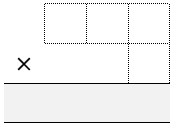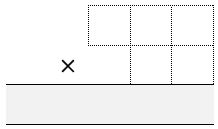More Dicey operations
In these multiplication and division games, you'll need to think strategically to get closest to the target.
More Dicey operations printable sheet
More Dicey operations scoring sheet
These challenges follow on from Dicey operations.
How close can you get to the target?
If you know how to multiply and divide, you may enjoy these challenges.
Click on the purple cog to select from the available options.
If you are working away from a computer, you could treat this as a game for two people, or play in two teams of two.
There are a few games to choose from.
Find a partner and a 1-6 dice, or preferably a 0-9 dice if you have one. The interactivity in Dice and Spinners can be used to simulate throwing different dice.
Throw the dice. Each player decides where to place that number in their grid. Continue until all the cells are filled.
Alternatively, collect all your numbers and then decide where to place them.
Game 1
Each of you draw a multiplication grid like this:

Throw the dice four times until all the cells are full.
Whoever has the product closest to 1000 wins.
There are two possible scoring systems:
- A point for a win. The first person to reach 10 wins the game.
- Each player keeps a running total of their "penalty points", the difference between their result and 1000 after each round. First to 5000 loses.
Game 2
Each of you draw a multiplication grid like this:

Throw the dice five times until all the cells are full.
Whoever has the product closest to 10000 wins.
There are two possible scoring systems:
- A point for a win. The first person to reach 10 wins the game.
- Each player keeps a running total of their "penalty points", the difference between their result and 10000 after each round. First to 10000 loses.
You could introduce a decimal point. The decimal point could take up one of the cells so the dice would only need to be thrown four times by each player. You will need to decide on an appropriate target.
Game 3
Each of you draw a division grid like this:

Throw the dice five times until all the cells are full.
Whoever has the answer closest to 1000 wins.
There are two possible scoring systems:
- A point for a win. The first person to reach 10 wins the game.
- Each player keeps a running total of their "penalty points", the difference between their result and 1000 after each round. First to 5000 loses.
These challenges follow on from Dicey operations and can be approached in a very similar way, so we suggest that you refer to the Teachers' Resources section of Dicey operations for appropriate guidance.
